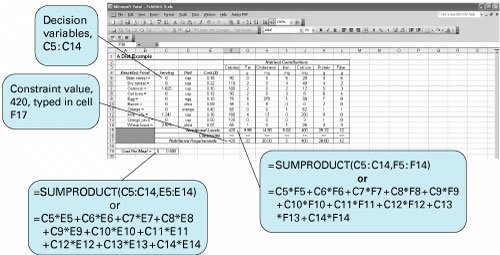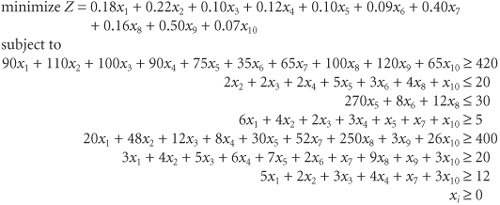A Diet Example
| Breathtakers, a health and fitness center, operates a morning fitness program for senior citizens . The program includes aerobic exercise, either swimming or step exercise, followed by a healthy breakfast in the dining room. Breathtakers' dietitian wants to develop a breakfast that will be high in calories , calcium, protein, and fiber, which are especially important to senior citizens, but low in fat and cholesterol. She also wants to minimize cost. She has selected the following possible food items, whose individual nutrient contributions and cost from which to develop a standard breakfast menu are shown in the following table:
The dietitian wants the breakfast to include at least 420 calories, 5 milligrams of iron, 400 milligrams of calcium, 20 grams of protein, and 12 grams of fiber. Furthermore, she wants to limit fat to no more than 20 grams and cholesterol to 30 milligrams. Decision VariablesThis problem includes 10 decision variables, representing the number of standard units of each food item that can be included in each breakfast: x 1 = cups of bran cereal x 2 = cups of dry cereal x 3 = cups of oatmeal x 4 = cups of oat bran x 5 = eggs x 6 = slices of bacon x 7 = oranges x 8 = cups of milk x 9 = cups of orange juice x 10 = slices of wheat toast The Objective FunctionThe dietitian's objective is to minimize the cost of a breakfast. The total cost is the sum of the individual costs of each food item: Model ConstraintsThe constraints are the requirements for the nutrition items:  Model SummaryThe linear programming model for this problem can be summarized as follows : Computer Solution with ExcelThe solution to our diet example using an Excel spreadsheet is shown in Exhibit 4.5. The decision variables (i.e., "servings" of each menu item) for our problem are contained in cells C5:C14 inclusive, and the constraint formulas are in cells F15 through L15. Cells F17 through L17 contain the constraint (right-hand-side) values. For example, cell F15 contains the constraint formula for calories, = SUMPRODUCT(C5:C14,F5:F14) . Then when the Solver Parameters screen is accessed, the constraint F15 >= F17 will be added in. This constraint formula in cell F15 could have been constructed by multiplying each of the values in column C by each of the corresponding column F cell values. The equivalent constraint formula in cell F15 to our SUMPRODUCT formula is = C5*F5+C6*F6+C7*F7+C8*F8+C9*F9+C10*F10+C11*F11+C12*F12+C13*F13+C14*F14 . Exhibit 4.5.(This item is displayed on page 118 in the print version) The objective function formula is contained in cell C19, = SUMPRODUCT(C5:C14,E5:E14) . In this case the objective function value is also computed by using the Excel SUMPRODUCT command rather than by individually multiplying each cell value in column C by each cell value in column E and then summing them. This would be a tedious formula to type into cell C19. Alternatively, the SUMPRODUCT() formula multiplies all the values in cells C5 through C14 by all the corresponding values in cells E5 through E14 and then sums them. The Solver dialog box for this problem is shown in Exhibit 4.6. Notice that the constraint box on this screen is not large enough to show all the constraints in the problem. Exhibit 4.6.(This item is displayed on page 118 in the print version) Solution AnalysisThe solution is x 3 = 1.025 cups of oatmeal x 8 = 1.241 cups of milk x 10 = 2.975 slices of wheat toast Z = $0.509 cost per meal The result of this simplified version of a real menu planning model (see the application box "The Evolution of the Diet Problem") is interesting in that it suggests a very practical breakfast menu. This would be a healthy breakfast for anyone . This model includes a daily minimum requirement of only 420 calories. The recommended daily calorie requirement for an adult is approximately 2,000 calories. Thus, the breakfast requirement is only about 21% of normal daily adult needs. In this model the dietitian must have felt a low-calorie breakfast was needed because the senior citizens had high-calorie lunches and dinners. An alternative approach to a healthy diet is a high-calorie breakfast followed by low-calorie, light meals and snacks the rest of the day. However, in this model, as the calorie requirements are increased above 420, the model simply increases the cups of oatmeal. For example, a 700-calorie requirement results in about 5 or 6 cups of oatmealnot a very appetizing breakfast. This difficulty can be alleviated by establishing upper limits on the servings for each food item and solving the model again with a higher calorie requirement. |
EAN: 2147483647
Pages: 358
